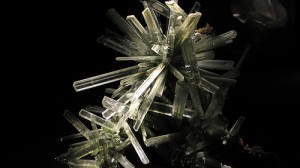Pliny the Elder, on selenite mined near Segóbriga (Segobriga near modern Saelices, Cuenca in Spain), Naturalis Historia 36.45:
Umorem hunc terræ quadam anima crystalli modo glaciari et in lapidem concrescere manifesto apparet, quod cum feræ decidere in puteos tales, medullæ in ossibus earum post unam hiemem in eandem lapidis naturam figurantur.
It is patently obvious that this is a liquid frozen like quartz by some spirit in the earth and hardened into rock, because when animals fall into their mineshafts, their bone marrow transforms into the same kind of rock after a single winter.
As given it sounds like something of an outlandish hypothesis, but apparently the only difficult part is the post unam hiemem “after a single winter”. Gypsum permineralization of animal remains is not unknown, but the process would certainly have taken longer than a season; it has been suggested that the animals found were prehistoric fossils and the assumption that they had fallen into the mine would just have been the simplest explanation of why animals would be found at such a depth to begin with.
As for crystalli modo glaciatur—today, of course, we wouldn’t say that any crystal, except possibly that of ice, would be formed by freezing; the usual explanation is precipitation out of a solution. Ancient Europe, though, was very weak on the chemistry of solutions: Aristotle, for example, asserted (in On Generation and Corruption) a drop of wine could not be mixed into ten thousand gallons of water, but that the mass of water would overpower and transform that wine into water if they came together. (Today we recognize contaminants can have effect even highly diluted; a drop in ten thousand gallons is about one part per billion and, to take a concrete example, 2 parts per billion is the maximum acceptable quantity of mercury in American drinking water.) With that level of understanding, saying that something ‘freezes the way that quartz crystal does’ (crystalli modo glaciatur) is probably as close to saying it ‘crystallizes’ that you’re going to get.
Still, to ‘rescue’ the text to something like:
It is patently obvious that this is a liquid crystallized and petrified by some geological process…
…is probably a task best left to Plinipedia, if that ever happens. (There really ought to be a project devoted to updating and correcting Pliny.)
[For crystallum.]

{ 2 } Comments